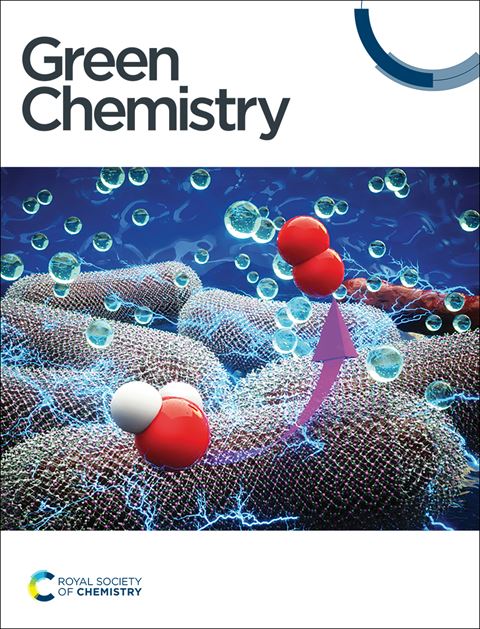Monolithic, hybrid and particulate lignin-based hydrogels for sustainable CO2 capture†
IF 9.2
1区 化学
Q1 CHEMISTRY, MULTIDISCIPLINARY
引用次数: 0
Abstract
Amine-infused hydrogels (AIHs) represent a promising platform for developing solid absorbents with improved CO2 absorption capacity. However, most of them rely on petroleum-based and toxic monomers. Lignin nanoparticles (LNPs) are becoming prominent players at the interface between sustainable nanomaterials technology and chemical science due to their high surface-area-to-mass ratio, which allows them to interact with multiple active compounds. Capitalizing on this spherical morphology and high surface area, the present work presents a strategy to prepare hybrid and particulate lignin-based hydrogels that can act as amine carriers for CO2 capture. The entire process is based on the internal stabilization of LNPs via intraparticle cross-linking process and subsequent base-catalyzed ring-opening reaction between LNPs and poly(ethylene glycol) diglycidyl ether in aqueous media. Upon swelling the hydrogel with an amine solution, hybrid and particulate lignin-based AIHs rapidly capture CO2 with a higher overall uptake compared to commonly used aqueous amine solutions under similar experimental conditions, while also stand and in some cases surpass the performance of other AIHs reported in the literature. Additionally, these new materials can be easily regenerated multiple times with minimal decrease in CO2 absorption capacity, demonstrating their potential application in decarbonization capture technologies.

单片,混合和颗粒木质素为基础的水凝胶可持续二氧化碳捕获†
胺注入水凝胶(AIHs)是开发具有提高二氧化碳吸收能力的固体吸附剂的一个有前途的平台。然而,它们大多依赖于石油基的有毒单体。木质素纳米颗粒(LNPs)由于其高表面积质量比,使其能够与多种活性化合物相互作用,正在成为可持续纳米材料技术和化学科学之间的重要参与者。利用这种球形形态和高表面积,目前的工作提出了一种制备混合和颗粒木质素基水凝胶的策略,这种水凝胶可以作为二氧化碳捕获的胺载体。整个过程是基于LNPs的内部稳定,通过颗粒内交联过程和随后的碱催化LNPs与聚乙二醇二甘油酯在水介质中的开环反应。在用胺溶液膨胀水凝胶后,在类似的实验条件下,与常用的胺水溶液相比,混合和颗粒木质素基AIHs以更高的总体吸收量快速捕获CO2,同时也达到并在某些情况下超过了文献中报道的其他AIHs的性能。此外,这些新材料可以很容易地多次再生,而二氧化碳吸收能力的下降最小,这表明它们在脱碳捕集技术中的潜在应用。
本文章由计算机程序翻译,如有差异,请以英文原文为准。
求助全文
约1分钟内获得全文
求助全文
来源期刊

Green Chemistry
化学-化学综合
CiteScore
16.10
自引率
7.10%
发文量
677
审稿时长
1.4 months
期刊介绍:
Green Chemistry is a journal that provides a unique forum for the publication of innovative research on the development of alternative green and sustainable technologies. The scope of Green Chemistry is based on the definition proposed by Anastas and Warner (Green Chemistry: Theory and Practice, P T Anastas and J C Warner, Oxford University Press, Oxford, 1998), which defines green chemistry as the utilisation of a set of principles that reduces or eliminates the use or generation of hazardous substances in the design, manufacture and application of chemical products. Green Chemistry aims to reduce the environmental impact of the chemical enterprise by developing a technology base that is inherently non-toxic to living things and the environment. The journal welcomes submissions on all aspects of research relating to this endeavor and publishes original and significant cutting-edge research that is likely to be of wide general appeal. For a work to be published, it must present a significant advance in green chemistry, including a comparison with existing methods and a demonstration of advantages over those methods.
 求助内容:
求助内容: 应助结果提醒方式:
应助结果提醒方式:


